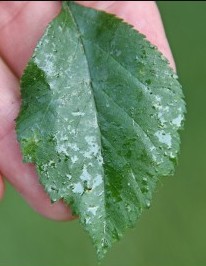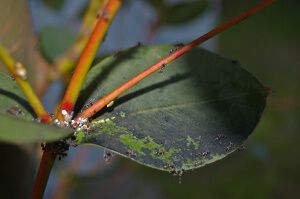Do your Crape Myrtles have shiny leaves and drip sap? You’re not alone! Our arborists are getting a lot of calls about trees, Crape Myrtles especially, being coated in sap and dripping it onto walkways, cars, and patio furniture. What most homeowners are surprised to find out is that this substance isn’t actually sap. It’s honeydew (aka insect excrement). Thankfully this nuisance can be easily fixed. Read on to learn more about honeydew, sooty mold, what insect could be causing your problem, and how to solve it.
Honeydew

Honeydew is one of the most common tree care issues we see in the DC Metro Area. Honeydew is the excrement of plant-sucking insects. This sticky substance is usually the first sign homeowners notice of an insect infestation. Many homeowners actually confuse honeydew with sap and only call us because the “sap” is a nuisance. They are usually surprised to hear that the problem they are dealing with is honeydew, which is a sign of an insect infestation.
Honeydew itself will not damage your tree; however, the insect infestation that causes it can weaken your tree over time causing an overall decline in your tree’s health and vitality. With honeydew, you also run the risk of developing Sooty Mold which can cause additional issues.
Sooty Mold

As the evening rains and thunderstorms continue, many homeowners will start to see a black substance develop on and/or below their trees that were having honeydew issues. This substance is called sooty mold.
Sooty mold is a fungus that grows on top of honeydew and coats the leaves of your trees to the point where they can no longer absorb sunlight. This interrupts photosynthesis and the tree will not be able to produce the nutrients it needs for survival. Plus it’s unsightly and a nuisance for many homeowners.
What’s Causing This Problem?

Crape Myrtle Aphids are one of the main causes of honeydew and sooty mood on Crape Myrtle trees. Found throughout May through September, these tiny insects do damage by feeding on the soft tissues and plant sap of Crepe Myrtle leaves. Crepe myrtle aphids reproduce rapidly, especially as the weather gets hotter. This makes it easy for them to quickly grow into a large population that will damage your tree.
Signs & Symptoms of Crape Myrtle Aphids
- Drooping Leaves
- Yellow Spots
- Black small dots on the underside of the leaves (these are what aphids look like to the naked eye)
- Honeydew
- Sooty Mold
- Ants on the Tree (Ants love the taste of honeydew. Trails of them going up and down the tree signal that honeydew and aphids are present.)
Crape Myrtle aphids are species-specific meaning it only feeds on crepe myrtles. As a homeowner you only need to worry about this type of aphid if you own a Crepe Myrtle; however, there are other types of aphids that prey on other tree species and show similar signs of infestation.
GETTING RID OF APHIDS

Organic Control through Beneficial Insects:
Aphids have many natural enemies, including lacewing larvae and ladybugs. We can release these predators on your property in order to control the population of these aphids. This is a great option for homeowners that are worried about chemicals on their property or have kids that would love to be involved in releasing the bugs on the property (while maintaining safe social distancing). Learn more about Beneficial Insect Release.
Traditional Control:
One of our Arborists will be able to craft an insecticide treatment that fits your landscape and kills the aphid infestation. These types of treatments will kill aphids on contact and when they feed on the tree. When not correctly applied these treatments can hurt beneficial insects which is why we advise against DIY home treatments. RTEC’s arborists and plant health care specialists abide by Integrated Pest Management Protocol. This protocol utilizes techniques that help target the intended pest while leaving the majority of the beneficial insect population unharmed.
If you have aphids on your Crape Myrtles book a consultation with an arborist using our online form or by calling 703.573.3029.
**NOTE: While this issue occurs nationwide, our current service area is limited to the Washington, DC Metropolitan Area.


